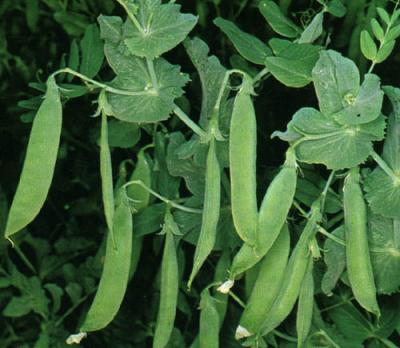
|
Peas
Scientific name:
Pisum sativum
Order/Family:
Fabales: Fabaceae
Common names:
Garden pea / English pea / green pea / snow pea / mangetout
Pests and Diseases:
African bollworm
Anthracnose
Aphids
Ascochyta blight
Bacterial blight
Broomrape
Cutworms
Downy mildew
Fusarium wilt
Leafmining flies (leafminers)
Pea blue butterfly
Powdery mildew
Root-knot nematodes
Snails (Giant East African Snail)
Spider mites
Storage pests
Thrips
Virus diseases
|
African bollworm (Helicoverpa armiguera) and other caterpillars
Various species of caterpillars feed on leaves and pods of peas. The most common are the African bollworm (Helicoverpa armiguera), the beet armyworm (Spodotera exigua) and hairy caterpillars (Arctiidae).
Caterpillars bore holes and feed on leaves, flower buds and maturing pods eating the seeds. They also attack young pods eating the pod wall and the developing seeds.
- Conserve natural enemies. Caterpillars have a wide range of natural enemies (parasitic wasps, predators and pathogens) that are important in their natural control.
- Inspect the crop regularly.
- Hand pick and kill caterpillars or feed them to poultry. This helps when their numbers are low and in small fields. However, if possible wear gloves when handling hairy caterpillars. Some of them have urticating hairs, which may cause skin irritation.
- If necessary, spray Bt or neem products. For more information on neem click here. For information on Bt click here Bt click here
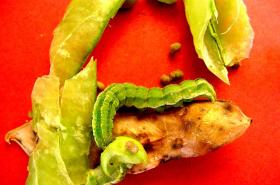
© A. M. Varela, icipe

African bo…

Beet armyw…
Aphids
Aphids are serious pests of peas. The pea aphid (Acyrthosiphon pisum), the cowpea aphid
(Acyrthosiphon pisum), and Myzus sp. (Aphis carccivora), are found on young leaves and growing points.
They suck sap from leaves, stems, blossoms and pods. Feeding by aphids causes leaf distortion and wilting. Heavily infested plants are stunted and produce fewer and smaller pods and seeds. The pea aphid may also transmit viruses such as pea enation mosaic virus, pea streak virus and pea leaf roll virus. Parasitic wasps and predators (hoverflies and ladybird beetles) are important for natural control of aphids.
- Parasitic wasps and predators (hoverflies and ladybird beetles) are important for natural control of aphids. Encourage natural enemies by interplanting peas with plants such as maize, which are host for aphids that do not attack peas, but allow predators to build up.
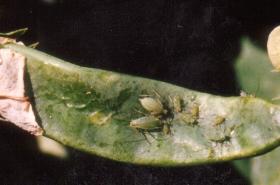
© A. M. Varela, icipe

Pea aphid

Pea aphid
Ascochyta blight (Ascochyta pisi, A. pinodella/Mycosphaerella pinodes)
Ascochyta blight attacks all parts of the plant. The infected leaves have small to large, round to irregular, dark brown to purple spots. Some of the spots may have ashy grey centres. The spots usually have purple margins and may have rings. Spots may join up to form brownish purple blotches. Severely diseased leaves shrivel and dry, starting at the base of the plant and progressing upwards. Spots on pods are sunken but have no rings. Stem symptoms consist of brownish to purple streaks. Infection from infected seeds can cause a brown to black stem and foot rot just above the soil line. Such plants may die and result in a poor stand in the field. Blossoms may be infected and drop off during extended wet weather.
The disease is favoured by cool wet weather, heavy dews in the morning and relative humidity above 89%.
- Use certified disease-free seeds.
- Use resistant varieties.
- Plough deeply pea stubble after harvest.
- Remove crop residues from the field after harvest.
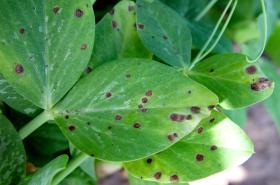
© A.M. Varela, icipe

Ascochyta …

Ascochyta …
Cutworms
Cutworms are the caterpillars of some moths. They cut-off seedlings at ground level, usually at night. They also feed on roots and leaves. They hide in the soil during the day.
- Plough field and remove weeds well ahead of planting the crop in the field. Ploughing exposes caterpillars to predators and to desiccation by the sun. If the field is planted soon after land preparation some cutworms may be alive and attack the new crop.
- Inspect soil carefully for the presence of cutworms when preparing land for planting.
- Make barriers to protect seedlings. Barriers can be made by wrapping paper, aluminium foil, thin cardboard, or similar materials around the base of young plant stems. Toilet rolls are handy as cutworm collars since they are readily available and will biodegrade into the soil.
- Monitor damage by counting damaged and freshly cut young plants.
- Collect and destroy cutworms. Cutworms are found in the soil close to damaged plants at daytime. Check for cutworms at dawn.
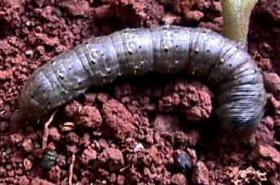
© A.M. Varela, icipe
Downy mildew (Peronospora pisi)
The fungal growth over leaf and pod is the most striking symptom. The fungal growth occurs on the lower leaf surface as well as on pods. Initially it is white but later it changes to a shade of violet and eventually to almost black. The disease may appear on pods even when it is not apparent on leaves. Affected pods show yellowish brown areas. Inside of the affected pods a white fungal growth can be seen. Peas in such pods are small and have brown spots. The disease is favoured by cool and moist conditions.
- Use certified disease-free seeds.
- Use resistant varieties, if available.
- Practice crop rotation. Rotate with non-legumes.
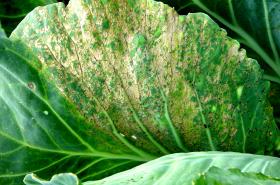
© A.M. Varela, icipe
Fusarium near-wilt (Fusarium oxysporum f. sp. pisi)
The fungus can attack plants at any stage of development. Distinct symptoms consist of yellowing of foliage and wilting leading to death of affected plants. The disease appears in scattered areas of the field and eventually may cover bigger areas. If stem of diseased plant is split, the pith is brick-red in colour. The disease can be seed-borne.
- Plant resistant varieties, if available.
- Use certified disease-free seeds.
- Practise crop rotation with non-legumes.
- Destroy crop residues.
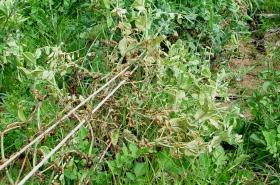
© A.M. Varela, icipe
Leafminers (Liriomyza spp. and Chromatomyia horticola)
Leafminers are major pests of peas. The maggots mine on leaves and pods. Mining of leaves affect the photosynthetic capacity of the plant. Mining of pods causes cosmetic damage leading to rejection of pods in varieties grown for their tender green pods such as snow peas and sugarsnap peas.
- Conserve natural enemies. Parasitic wasps usually keep leafminers under control. Avoid use of pesticides that kill these wasps and other natural enemies. For more information on natural enemies click here
- If necessary spray crop with neem products. For more information on neem click here
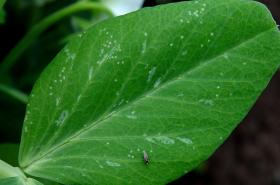
© A.M. Varela, icipe
The pea blue butterfly (Lampides boeticus)
It is a pest of peas during the flowering and podding stages. The adult is a butterfly bright blue (males) to brown (females) in colour. They have small tails at the edge of the hind wings, and two eye-like spots near each tail. The wing undersides are sandy-brown with creamy transverse bands. The moth lays eggs singly on the shoots, on or near the young flowers. Upon hatching the small caterpillars are yellow in colour, and are very active feeding first inside the flower and then inside the developing pod eating the young seeds. On small pods the caterpillar makes a hole in the pod wall in order to reach the seeds. Older caterpillars are grub-like green or pear white in colour and reach up to 15 mm when fully-grown. Pupation takes place amongst debris and leaves on the ground, under stones, or even in a curled-up, withered leaf on the plant.
- Conserve natural enemies. Parasitic wasps and flies attack caterpillars and are important for the natural control of this pest.
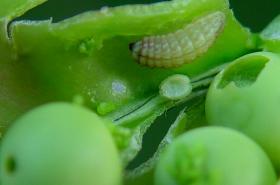
© A.M. Varela, icipe
Powdery mildew (Erysiphe polygoni)
It is characterised by a white powdery growth on the leaves, stems and pods. The initial symptoms consist of tiny slightly discoloured spots on the upper surface of leaves. Theses spots enlarge and become covered with powdery fungal growth. The tissue beneath affected areas may turn purple and later brown. If infection is severe, affected plants turn brown and die. Affected seeds become brown. Water stress accelerates mildew development. Warm days and cool nights favour disease development. The fungus is seed-borne.
- Use certified disease-free seeds.
- Treat own seeds by soaking for 30 minutes in 122° F / 50° C.
- Plant resistant varieties, if available.
- Practice crop rotation with non-legumes.
- Plough under crop residues after harvest.
- Spray with sulphur products, where local administration permits.
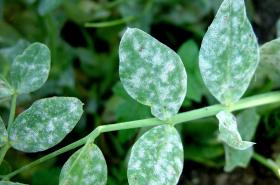
© A.M. Varela, icipe
Root-know nematode (Meloidogyne incognita, M. javanica)
Root-knot nematode galls on tomato roots. Root-knot nematodes (Meloidogyne incognita / M. javanica) affected plants are normally stunted and eventually wilt and die. The most characteristic symptom is formation of root galls (knots) and these can be seen with the naked eye. Affected roots rot.
- Practise a 2-3 year crop rotation with cereals, maize or grasses.
- Direct surface irrigation water from new to old bean fields.
- Maintain fields weed-free.
- Uproot and destroy entire plants after harvest.
- Amend soil with neem cake or green manure of marigold or sunnhemp.
- Maintain high levels of organic matter in the soil.
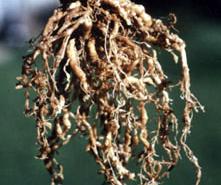
© Bridge J., IIP. Courtesy of Ecoport (www.ecoport.org)
Spider mites (Tetranychus spp.)
Spider mites cause small white yellow specks on leaves. If spider mites are present in large numbers the leaf may be dry and fall off. Plants grow poorly when they are heavily infested. When infestations are heavy the spider mites will go up on the supports for the plants and accumulate on the tips so that the wind can carry them to new crops.
- Monitor regularly the crop to determine the presence and level of infestations of spider mites.
- Conserve natural enemies. A number of predators are known to feed on spider mites. They usually keep spider mites under control provided broad-spectrum pesticides are not applied and the crop is irrigated properly.
- Keep field free of weeds and destroy or compost crop residues immediately after harvesting. Crop residues from an infested field should be destroyed.
- Do not plant a new crop near an infested field.
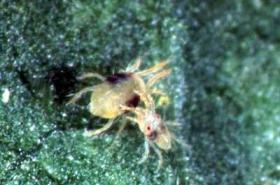
© Warwick HRI, University of Warwick.
Thrips (Sericothrips spp, Frankliniella occidentalis, and Thrips tabaci
Thrips suck plant tissues causing withering of the plant. Infested parts show silvery white discolouration. Thrips feeding on pods cause tinny scars and blemishes. The damaged pods may not be noticed at harvest, but scars become more visible during post harvest transport to market. Thrips damage lowers the market value of snow peas and sugar snaps (which are eaten as pods) and may lead to rejection. Their feeding punctures may also be a point of entry for disease-causing fungi such as Ascochyta. Thrips are difficult to control since they often migrate into peas from surrounding vegetable crops and weeds.
- Conserve natural enemies. Anthocorid bugs and predatory mites are important natural enemies of thrips. Avoid use of of broad-spectrum pesticides that kill natural enemies
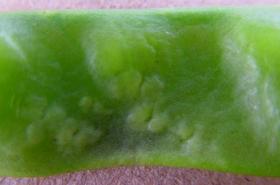
© A.M. Varela, icipe
Virus diseases
Peas are susceptible to a large number of aphid- transmitted viruses, which can produce diseases individually or in combination. The main viruses infecting pea are pea enation mosaic, pea streak and bean yellow mosaic.
1) Pea enation mosaic virus (PEMV)
In addition to pea, PEMV also infects broad bean, sweet pea, and alfalfa. It probably overseasons in many common perennial legumes. The virus is spread in nature most efficiently by the pea aphid (Acyrthosiphon pisum) and to a lesser extent by the green peach aphid (Myzus persicae). The virus is transmitted in a persistent (circulative) manner. Infected pea plants develop mosaic and chlorotic vein flecking (appears as translucent windows) and veinal enations (blisterlike outgrowths), which are very characteristic for pea enation mosaic virus. Plants are stunted, and proliferation of basal branches is common. Pods are distorted, split open, and may show prominent enations.
2) Bean yellow mosaic virus (BYMV)
Bean yellow mosaic virus is transmitted by at least 20 aphid species in a non-persistent manner. The symptoms depend upon the strain of virus involved. The pea strain, for example, causes a very bright yellow mosaic whereas the more typical isolates produce a dull light and dark green mosaic. Symptoms are masked or delayed at low temperatures (below 15.6°C), but develop at 18.3° to 23.9°C. Seed transmission is absent or very rare in pea and several other legumes.
- Control aphids.
- Plant resistant varieties, if available.
- Remove perennial legumes bordering the planting area to reduce the primary virus reservoir.
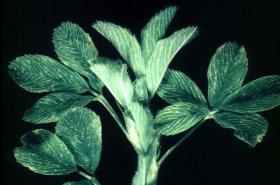
© Courtesy of: The Food and Environment Research Agency (Fera) , Crown Copyright
| General Information and Agronomic Aspects | Information on Diseases | |||
| Information on Pests | Information Source Links |
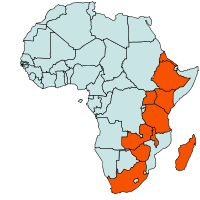 |
| Geographical Distribution of Peas in Africa |
Peas are cultivated for the fresh green seeds, tender green pods, dried seeds and foliage. Dry seeds are used for food and feed. For food, they are cooked whole, split or ground into flour, and boiled or roasted. Large amounts are canned. Fresh peas are canned or frozen in the immature form. They are a major vegetable and commercial crop. Some cultivars are grown for their tender green pods such as snap peas (sugar snaps) and snow peas (sweet peas) mainly for export. The crop is also suitable as forage, hay, silage and green manure. Kenya export of garden peas in 2005 amounted to 2,206 tons at a value of KSh 729 million, and of snow peas 1,739 tons at a value of KSh 448 million. Total area of garden peas in 2005 was 5,313 hectares and for snow peas 1,550 hectares for both local and export market.
Nutritive Value per 100 g of edible Portion
| Raw or Cooked Peas | Food Energy (Calories / %Daily Value*) |
Carbohydrates (g / %DV) |
Fat (g / %DV) |
Protein (g / %DV) |
Calcium (g / %DV) |
Phosphorus (mg / %DV) |
Iron (mg / %DV) |
Potassium (mg / %DV) |
Vitamin A (I.U) |
Vitamin C (I.U) |
Vitamin B 6 (I.U) |
Vitamin B 12 (I.U) |
Thiamine (mg / %DV) |
Riboflavin (mg / %DV) |
Ash (g / %DV) |
| Peas, edible-podded, raw (Snowpeas) | 42.0 / 2% | 7.5 / 3% | 0.2 / 0% | 2.8 / 6% | 43.0 / 4% | 53.0 / 5% | 2.1 / 12% | 200 / 6% | 1087 IU / 22% | 60.0 / 100% | 0.2 / 8% | 0.0 / 0% | 0.2 / 10% | 0.1 / 5% | 0.6 |
| Green Peas cooked | 84.0 / 4% | 15.6 / 5% | 0.2 / 0% | 5.4 / 11% | 27.0 / 3% | 117 / 12% | 1.5 / 9% | 271 / 8% | 801 IU / 16% | 14.2 / 24% | 0.2 / 11% | 0.0 / 0% | 0.3 / 17% | 0.1 / 9% | 0.9 |
| Green Peas raw | 81.0 / 4% | 14.5 / 5% | 0.4 / 1% | 5.4 / 11% | 25.0 / 2% | 108 / 11% | 1.5 / 8% | 244 / 7% | 765 IU / 15% | 40.0 / 67% | 0.2 / 8% | 0.0 / 0% | 0.3 / 18% | 0.1 / 8% | 0.9 |
| Peas, mature seeds, sprouted, cooked | 98.0 / 5% | 17.1 / 6% | 0.5 / 1% | 7.0 / 14% | 26.0 / 3% | 24.0 / 2% | 1.7 / 9% | 268 / 8% | 107 IU / 2% | 6.6 / 11% | 0.1 / 6% | 0.0 / 0% | 0.2 / 14% | 0.3 / 17% | 1.0 |
| Peas, mature seeds, sprouted, raw | 124 / 6% | 27.1 / 9% | 0.7 / 1% | 8.8 / 18% | 36.0 / 4% | 165 / 17% | 2.3 / 13% | 381 / 11% | 166 IU / 3% | 10.4 / 17% | 0.3 / 13% | 0.0 / 0% | 0.2 / 15% | 0.2 / 9% | 1.1 |
| Pigeon Peas (Red Gram) cooked | 121 / 6% | 23.2 / 8% | 0.4 / 1% | 6.8 / 14% | 43.0 / 4% | 119.0 / 12% | 1.1 / 6% | 384 / 11% | 3.0 IU / 0% | 0.0 / 0% | 0.1 / 3% | 0.0 / 0% | 0.1 / 10% | 0.0 / 0% | 1.1 |
| Pigeon Peas (Red Gram) raw | 343 / 17% | 62.8 / 21% | 1.5 / 2% | 21.7 / 43% | 130 / 13% | 367 / 37% | 5.2 / 29% | 1392 / 40% | 28.0 IU / 1% | 0.0 / 0% | 0.3 / 14% | 0.0 / 0% | 0.6 / 43% | 0.2 / 11% | 3.5 |
Peas grown for fresh consumption of their seeds (green or garden peas) are harvested as soon as the pods are well-filled but the seeds are still tender and sweet. Generally, the pod is discarded after the peas are removed; but some young tender varieties have an edible pod, which are often used in Chinese dishes. Green peas are highly perishable and the sugar to starch conversion begins the moment they are picked.
Some varieties of green peas (garden peas):
- "Green Feast"
- "Earlicrop" - a short, early maturing variety that does not require staking
- "Onward" - a climbing variety suitable for wet season production
- "Alderman" - a late maturing variety that requires staking.
Snow peas or sugar peas have edible flat pods and very small seeds. They are harvested when very young, just as the seeds start to form. If not picked at this stage, they can be shelled and eaten as garden peas, but are starchier and not as sweet.
Sugar snaps are also an edible pod pea but have larger and sweeter seeds and a thicker pod than snow peas, but more delicate than the green peas. They are grown to full size and then eaten like snap beans.
Both snow peas and sugar snap peas last much longer than the green pea.
The main varieties of snow peas grown in Kenya (Kenya (Horticultural Crops Development Authority, Kenya, HCDA).
| Variety | Flower colour | Plant height (cm) | Pod size (cm) | Maturity |
| "Mammoth Melting Sugar" | White | 180-200 | 8-12 | |
| "Dwarf Grey Sugar" | Purple | 70 | 7-8 | Early maturing |
| "Oregon Sugar Pod" | Purple | 60-70 | 8-10 | Early maturing |
| "Sugar Snap" | White | 60-70 | 6.5-7 | Early maturing |
| "Toledo" | White | 60-65 |
In soils with low organic matter, up to 20tons/ha of manure or compost should be applied before planting, as well as up to 200 kg/ha of rock phosphate. Being a legume, peas are not responsive to nitrogen fertiliser, however it is recommended to inoculate the seeds with rhizobium (any of a genus (Rhizobium) of nitrogen-fixing bacteria found in nodules on the roots of certain leguminous plants) to encourage the plants to fix enough nitrogen from the atmosphere. Inoculating with rhizobium has been shown to increase yields by up to 100%. Mix crop residues and organic matter in the top 20cm of the soil prior to planting. This destroys current weed growth and provides a granular bed for seeding.
A suitable crop rotation program involving grains, potatoes and brassicas should be used. For good quality fresh market peas staking is recommended.
For dry peas the whole plant can be uprooted when about 80% of pods have turned brown and dry. The haulm is then either left in the field or carried to a threshing place to dry completely, after which the peas are threshed and winnowed. For storage of dry peas please see chapter on storage pests (click here).
|
African bollworm (Helicoverpa armiguera) and other caterpillars
Various species of caterpillars feed on leaves and pods of peas. The most common are the African bollworm (Helicoverpa armiguera), the beet armyworm (Spodotera exigua) and hairy caterpillars (Arctiidae). | 
African bollworm
African bollworm (Helicoverpa armiguera) feeding on peas. Fully grown caterpillars are 3-4 cm long. © A. M. Varela, icipe |
|
What to do:
|
|
Leafminers (Liriomyza spp. and Chromatomyia horticola) Leafminers are major pests of peas. The maggots mine on leaves and pods. Mining of leaves affect the photosynthetic capacity of the plant. Mining of pods causes cosmetic damage leading to rejection of pods in varieties grown for their tender green pods such as snow peas and sugarsnap peas. | 
Leafminer
Leafminer fly and damage caused by adult leafminer on peas. © A.M. Varela, icipe |
|
What to do:
|
- Agricultural Information Center (2003). Fruits and Vegetables Technical handbook, revised edition.
- Alan McNab (2007). Pea Diseases. Vegetable Disease Identification. Department of Plant Pathology, Penn State University. http://plantpath.psu.edu
- CABI (2005). Crop Protection Compendium, 2005 Edition. © CAB International Publishing. Wallingford, UK. www.cabi.org
- East African Seed Co. Ltd. Africa's Best Grower's Guide www.easeed.com
- Green peas. www.agriculture.kzntl.gov.za
- Hagedon, D.J. (Ed) (1984). Compendium of Pea Diseases. American Phytopathological Society Publication. ISBN-13: 978-089054602.
- Horticultural Crops Development Authority (HCDA). Export Crop Bulletin: No 1. June 1996. Snowpeas (Pisun sativum). Leguminosaceae.
- Mark Gaskell. Edible-pod pea production in California. Vegetable and Information Center. Vegetable Production Series. ISBN: 978-1-60107-024-1. www.anrcatalog.ucdavis.edu
- Ministry of Agriculture (2006). Economic Review of Agriculture. Republic of Kenya.
- Muehlbauer, F.J.,Tullu, A. (1997). New crop fact sheet. Pisum Sativum L. www.hort.purdue.edu
- Myers, J.R., Colt, W.M., Swanson, M.A. (1994). Beans and Peas. A Pacific Northwest Extension Publication, Idaho, Oregon, Washington. www.cals.uidaho.edu
- NSF Center for Integrated Pest Managment. Crop profile for peas (green) in Idaho
- Nutrition Data www.nutritiondata.com.
- Ohio State University. Ohio State University Extension Fact Sheet Horticulture and Crop Science: www.ohioline.osu.edu
- PIP. Technical Itinerary Pea. With technical collaboration of Louis Labuschagne of Real IPM. PIP-COLEACP, Brussels, Belgium. www.coleacp.org
- Purdue University. Center for New Crops & Plant Products. www.hort.purdue.edu
- Sherf, A.F., MacNab, A.A. (1986). Vegetable Diseases and Their Control. A Wiley-Interscience Publication. ISBN: 0 471 05860 2.

 Back
Back
